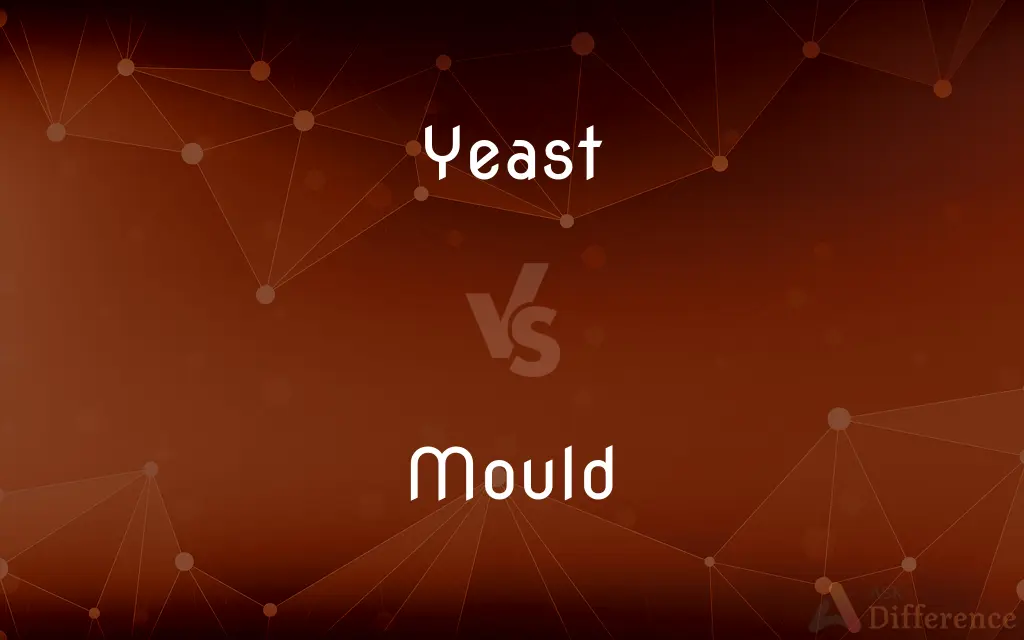Yeast vs. Mould — What's the Difference?
Edited by Tayyaba Rehman — By Fiza Rafique — Published on January 3, 2024
Yeast are unicellular fungi used in fermentation, while moulds are multicellular fungi that form filaments and potentially produce mycotoxins.

Difference Between Yeast and Mould
Table of Contents
ADVERTISEMENT
Key Differences
Yeast is a type of fungus that is single-celled and is typically used in the baking and brewing industries due to its ability to ferment sugars, producing carbon dioxide and alcohol. Mould, on the other hand, is a multicellular fungus that can appear as fuzzy growth on organic matter, often associated with decay and spoilage, but also used in the production of certain cheeses.
In terms of reproduction, yeast cells usually reproduce asexually by a process called budding, where a new cell grows out of the body of a parent cell. Moulds reproduce by producing large numbers of tiny spores, which can be spread through the air to new substrates where they can germinate and form new mould colonies.
When considering their ecological roles, yeasts are important in the carbon cycle, breaking down sugars in environments ranging from soil to plant nectar to the guts of insects. Moulds are decomposers in the ecosystem, breaking down dead organic material, which recycles nutrients back into the soil.
Yeast is typically found in moist, nutrient-rich environments and can be cultivated intentionally for commercial use. Mould is more ubiquitous, growing in a variety of conditions, often where there is excess moisture and can be both a nuisance and a health hazard in indoor environments.
While yeast is often seen as beneficial in food production and has few pathogenic species, moulds can be both beneficial and harmful. Some moulds are used in antibiotic production or as food, like certain blue cheeses, while others can cause allergic reactions, respiratory problems, or produce toxins.
ADVERTISEMENT
Comparison Chart
Cellular Structure
Unicellular
Multicellular
Reproduction
Budding
Spore Formation
Role in Food
Fermentation
Spoilage or Specialty Foods
Health Impact
Generally safe, few pathogens
Can be allergenic or toxic
Industrial Use
Brewing, Baking
Antibiotics, Cheese Production
Compare with Definitions
Yeast
A single-celled fungus that can cause dough to rise through fermentation.
She added yeast to the dough to make her pastries fluffy.
Mould
A type of fungus that grows in multicellular filaments called hyphae.
The bread was old and covered in green mould.
Yeast
A biological leavening agent that produces carbon dioxide gas.
The bread's volume doubled due to the yeast's activity.
Mould
A frame or template for shaping a solid substance.
The sculpture was cast in a bronze mould.
Yeast
A microorganism used in fermentation to produce beer and bread.
The yeast began to bubble, signaling it was ready to bake bread.
Mould
To form something into a particular shape.
She moulded the clay into a vase.
Yeast
A living ingredient in brewing that converts sugars into alcohol.
Without yeast, there would be no beer to enjoy.
Mould
A growth-producing spoilage on organic matter, often seen as fuzzy patches.
Mould had formed on the wet walls of the basement.
Yeast
Any of various unicellular fungi of the genus Saccharomyces, especially S. cerevisiae, reproducing asexually by budding or sexually through the production of ascospores and capable of fermenting carbohydrates.
Mould
An organism that can cause decay and release spores into the air.
We found mould in the corner of the shower.
Yeast
Any of numerous fungi that exhibit a one-celled growth form and reproduce by budding, including certain candidas that can cause infections in humans.
Mould
Variant of mold1.
Yeast
Froth consisting of yeast cells together with the carbon dioxide they produce in the process of fermentation, present in or added to fruit juices and other substances in the production of alcoholic beverages.
Mould
Variant of mold2.
Yeast
A powdered or compressed commercial preparation of yeast cells, used chiefly as a leavening agent or as a dietary supplement.
Mould
Variant of mold3.
Yeast
An agent of ferment or activity
Political agitators who are the yeast of revolution.
Mould
Standard spelling of from2=Canadian form
Yeast
An often humid, yellowish froth produced by fermenting malt worts, and used to brew beer, leaven bread, and also used in certain medicines.
Mould
Alternative spelling of mold
Yeast
A single-celled fungus of a wide variety of taxonomic families.
Mould
Alternative spelling of mold#Etymology_3
Yeast
A true yeast or budding yeast in order Saccharomycetales.
Mould
Standard spelling of from2=Canadian form
Yeast
Candida, a ubiquitous fungus that can cause various kinds of infections in humans.
Mould
Alternative spelling of mold
Yeast
(figuratively) A frothy foam.
Mould
See Mold, Molder, Moldy, etc.
Yeast
To ferment.
Mould
Loose soil rich in organic matter
Yeast
(of something prepared with a yeasted dough) To rise.
Mould
A fungus that produces a superficial growth on various kinds of damp or decaying organic matter
Yeast
To exaggerate.
Mould
Sculpture produced by molding
Yeast
The foam, or troth (top yeast), or the sediment (bottom yeast), of beer or other in fermentation, which contains the yeast plant or its spores, and under certain conditions produces fermentation in saccharine or farinaceous substances; a preparation used for raising dough for bread or cakes, and making it light and puffy; barm; ferment.
Mould
Container into which liquid is poured to create a given shape when it hardens
Yeast
Spume, or foam, of water.
They melt thy yeast of waves, which marAlike the Armada's pride, or spoils of Trafalgar.
Mould
Form in clay, wax, etc;
Model a head with clay
Yeast
A form of fungus which grows as individual rounded cells, rather than in a mycelium, and reproduces by budding; esp. members of the orders Endomycetales and Moniliales. Some fungi may grow both as a yeast or as a mycelium, depending on the conditions of growth.
Mould
Form by pouring (e.g., wax or hot metal) into a cast or mold;
Cast a bronze sculpture
Yeast
A commercial leavening agent containing yeast cells; used to raise the dough in making bread and for fermenting beer or whiskey
Mould
Make something, usually for a specific function;
She molded the riceballs carefully
Form cylinders from the dough
Shape a figure
Work the metal into a sword
Yeast
Any of various single-celled fungi that reproduce asexually by budding or division
Yeast
A substance containing yeast cells, used as a dietary supplement.
He takes yeast tablets for their B-vitamins.
Common Curiosities
What is yeast?
Yeast is a single-celled fungus used in fermentation and baking.
Where is yeast commonly found?
Yeast is commonly found in soil, plants, and the skins of fruits.
Is mould ever intentional in food?
Yes, some cheeses require mould for their distinctive flavors and textures.
Can yeast cause disease?
While most yeast is not harmful, some species can cause infections, particularly in immunocompromised individuals.
What conditions do moulds prefer for growth?
Moulds prefer moist, warm conditions and organic material to grow on.
How does yeast contribute to bread making?
Yeast ferments sugars in dough, producing gas that makes bread rise.
Can mould be used in food?
Yes, certain moulds are used in the production of foods like cheese and soy products.
Is all mould harmful?
Not all mould is harmful; some are used in food production, but others can cause health issues.
How can I tell if food has yeast or mould on it?
Yeast is usually incorporated into food, while mould appears as a surface growth.
What is a common use of yeast besides baking?
Yeast is commonly used in brewing to ferment beer and wine.
What are the benefits of yeast?
Yeast helps in food production, health supplements, and has various industrial uses.
Can mould be cleaned from surfaces?
Yes, but it requires proper cleaning materials and methods to prevent spore spread.
Does yeast need oxygen to grow?
Some yeasts require oxygen (aerobic), while others do not (anaerobic).
How can you prevent mould growth at home?
Control humidity levels, fix leaks, and clean regularly to prevent mould growth.
Are yeast and mould related?
Both are fungi, but they differ in form and function.
Share Your Discovery

Previous Comparison
Abstract Class in Java vs. Interface in Java
Next Comparison
Bony Fish vs. Cartilaginous FishAuthor Spotlight
Written by
Fiza RafiqueFiza Rafique is a skilled content writer at AskDifference.com, where she meticulously refines and enhances written pieces. Drawing from her vast editorial expertise, Fiza ensures clarity, accuracy, and precision in every article. Passionate about language, she continually seeks to elevate the quality of content for readers worldwide.
Edited by
Tayyaba RehmanTayyaba Rehman is a distinguished writer, currently serving as a primary contributor to askdifference.com. As a researcher in semantics and etymology, Tayyaba's passion for the complexity of languages and their distinctions has found a perfect home on the platform. Tayyaba delves into the intricacies of language, distinguishing between commonly confused words and phrases, thereby providing clarity for readers worldwide.
















































